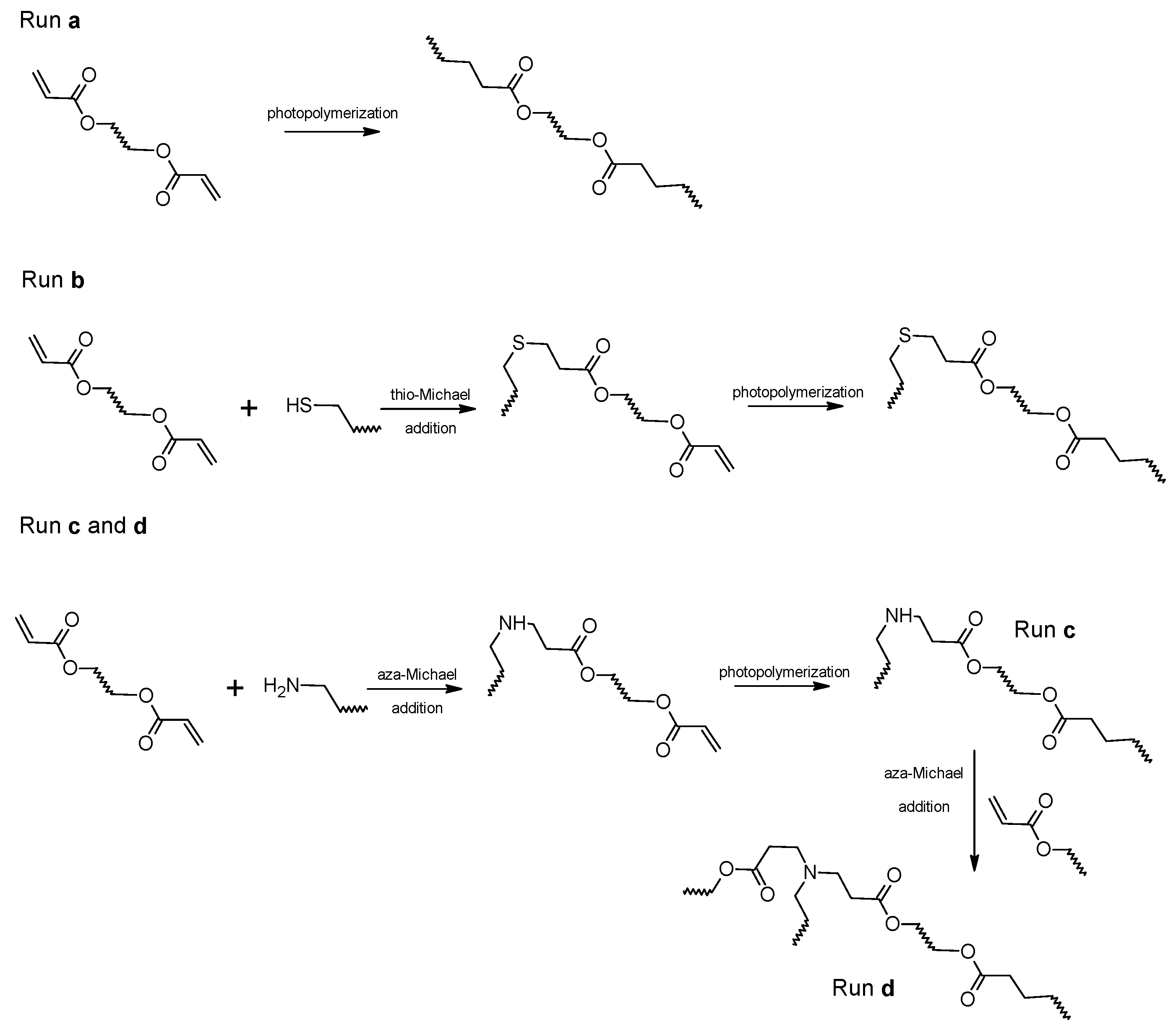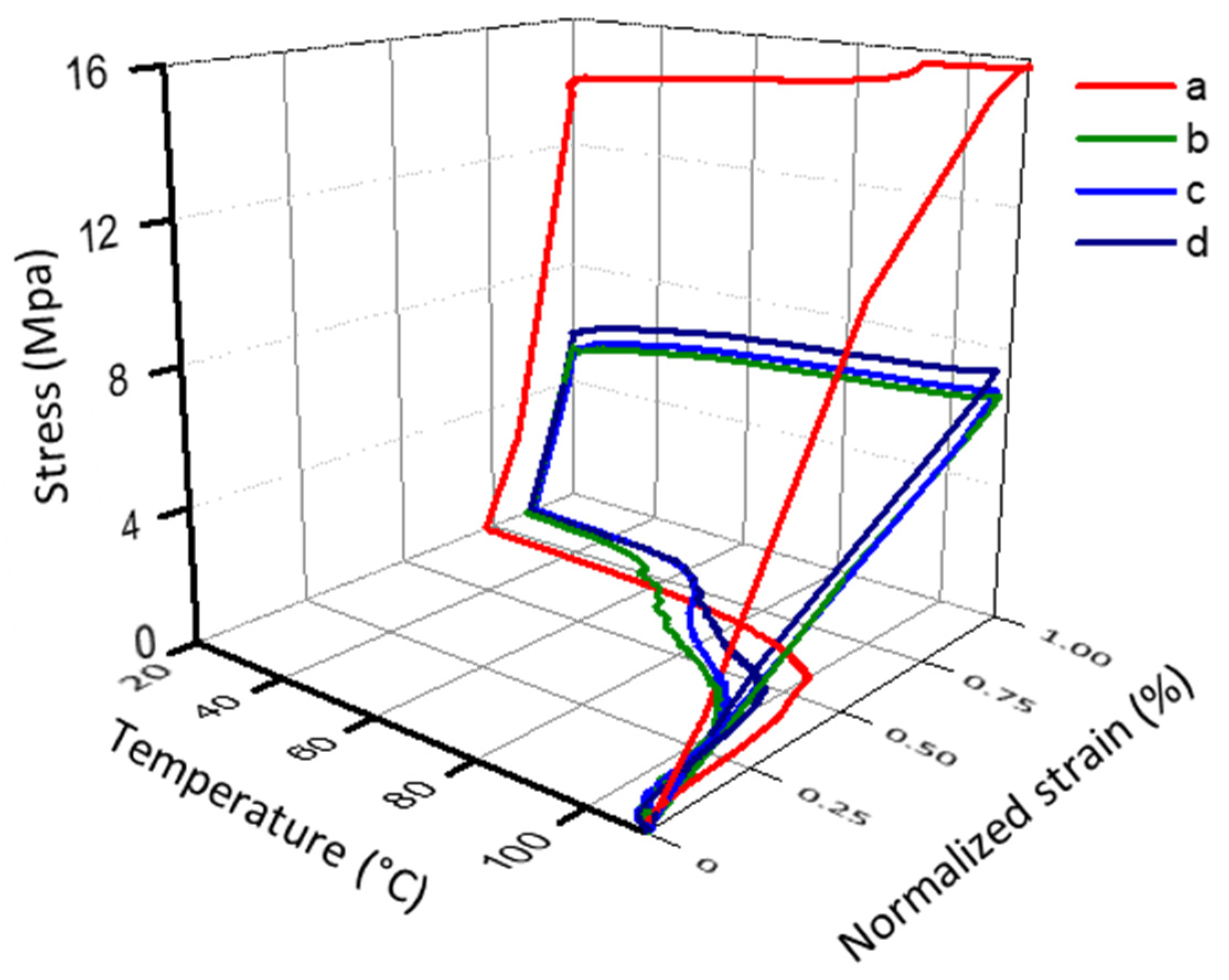On-Demand Photopolymerization of Fiber-Reinforced Polymers Exhibiting the Shape Memory Effect
Abstract
:1. Introduction
2. Materials and Methods
3. Results and Discussion
4. Conclusions
Author Contributions
Funding
Institutional Review Board Statement
Informed Consent Statement
Data Availability Statement
Conflicts of Interest
References
- Ratna, D.; Karger-Kocsis, J. Recent advances in shape memory polymers and composites: A review. J. Mater. Sci. 2008, 43, 254–269. [Google Scholar] [CrossRef]
- Meng, Q.; Hu, J. A review of shape memory polymer composites and blends. Compos. Part A Appl. Sci. Manuf. 2009, 40, 1661–1672. [Google Scholar] [CrossRef]
- Gall, K.; Dunn, M.L.; Liu, Y.; Finch, D.; Lake, M.; Munshi, N.A. Shape memory polymer nanocomposites. Acta Mater. 2002, 50, 5115–5126. [Google Scholar] [CrossRef]
- Park, Y.C.; Lee, J.K.; Lee, G.C. Development of an expert system for evaluation of the strength of matrix shape memory composites. Compos. Struct. 2007, 77, 241–248. [Google Scholar] [CrossRef]
- Leng, J.; Lan, X.; Liu, Y.; Du, S. Shape-memory polymers and their composites: Stimulus methods and applications. Prog. Mater. Sci. 2011, 56, 1077–1135. [Google Scholar] [CrossRef]
- Ohki, T.; Ni, Q.-Q.; Ohsako, N.; Iwamoto, M. Mechanical and shape memory behavior of composites with shape memory polymer. Compos. Part A Appl. Sci. Manuf. 2004, 35, 1065–1073. [Google Scholar] [CrossRef]
- Hu, J. Shape Memory Polymers: Fundamentals, Advances and Applications; Smithers Rapra Technology Ltd.: Shawbury, England, 2014. [Google Scholar]
- Yang, J.H.; Chun, B.C.; Chung, Y.-C.; Cho, J.W.; Cho, B.G. Vibration control ability of multilayered composite material made of epoxy beam and polyurethane copolymer with shape memory effect. J. Appl. Polym. Sci. 2004, 94, 302–307. [Google Scholar] [CrossRef]
- Lan, X.; Liu, Y.; Lv, H.; Wang, X.; Leng, J.; Du, S. Fiber reinforced shape-memory polymer composite and its application in a deployable hinge. Smart Mater. Struct. 2009, 18, 024002. [Google Scholar] [CrossRef] [Green Version]
- Nair, D.P.; Cramer, N.B.; Scott, T.F.; Bowman, C.N.; Shandas, R. Photopolymerized thiol-ene systems as shape memory polymers. Polymer 2010, 51, 4383. [Google Scholar] [CrossRef] [PubMed] [Green Version]
- Retailleau, M.; Ibrahim, A.; Croutxé-Barghorn, C.; Allonas, X. New design of highly homogeneous photopolymer networks for shape memory materials. RSC Adv. 2016, 6, 47130–47133. [Google Scholar] [CrossRef]
- Berg, G.J.; McBride, M.K.; Wang, C.; Bowman, C.N. New directions in the chemistry of shape memory polymers. Polymer 2014, 55, 5849–5872. [Google Scholar] [CrossRef]
- Nair, D.P.; Cramer, N.B.; Gaipa, J.C.; McBride, M.K.; Matherly, E.M.; McLeod, R.R.; Shandas, R.; Bowman, C.N. Two-Stage Reactive Polymer Network Forming Systems. Adv. Funct. Mater. 2012, 22, 1502–1510. [Google Scholar] [CrossRef]
- Nair, D.P.; Cramer, N.B.; McBride, M.K.; Gaipa, J.C.; Shandas, R.; Bowman, C.N. Enhanced two-stage reactive polymer network forming systems. Polymer 2012, 53, 2429–2434. [Google Scholar] [CrossRef] [PubMed] [Green Version]
- Nair, D.P.; Cramer, N.B.; McBride, M.K.; Gaipa, J.C.; Lee, N.C.; Shandas, R.; Bowman, C.N. Fabrication and Characterization of Novel High Modulus, Two-Stage Reactive Thiol-Acrylate Composite Polymer Systems. Macromol. Symp. 2013, 329, 101–107. [Google Scholar] [CrossRef]
- Chatani, S.; Wang, C.; Podgórski, M.; Bowman, C.N. Triple shape memory materials incorporating two distinct polymer networks formed by selective thiol–Michael addition reactions. Macromolecules 2014, 47, 4949–4954. [Google Scholar] [CrossRef]
- Cosola, A.; Sangermano, M.; Terenziani, D.; Conti, R.; Messori, M.; Grützmacher, H.; Pirri, C.F.; Chiappone, A. DLP 3D-printing of shape memory polymers stabilized by thermoreversible hydrogen bonding interactions. Appl. Mater. Today 2021, 23, 101060. [Google Scholar] [CrossRef]
- Retailleau, M.; Ibrahim, A.; Croutxé-Barghorn, C.; Allonas, X.; Ley, C.; Le Nouen, D. One-pot three-step polymerization system using double click Michael addition and radical photopolymerization. ACS Macro Lett. 2015, 4, 1327–1331. [Google Scholar] [CrossRef]
- Retailleau, M.; Pierrel, J.; Ibrahim, A.; Croutxé-Barghorn, C.; Allonas, X. Sequenced click chemistry and photopolymerization: A new approach toward semi-interpenetrating polymer networks. Polym. Adv. Technol. 2016, 28, 491. [Google Scholar] [CrossRef]
- Retailleau, M.; Ibrahim, A.; Croutxé-Barghorn, C.; Allonas, X. Towards two-step photopolymerization using aza-Michael click addition. Prog. Org. Coat. 2016, 100, 51–55. [Google Scholar] [CrossRef]
- Gunes, I.S.; Cao, F.; Jana, S.C. Evaluation of nanoparticulate fillers for development of shape memory polyurethane nanocomposites. Polymer 2008, 49, 2223. [Google Scholar] [CrossRef]



| Run a | Run b | Run c | Run d | |
|---|---|---|---|---|
| Eg (GPa) | 7.8 | 9.1 | 7.8 | 8.2 |
| Er (GPa) | 2.3 | 1.7 | 1.2 | 1.7 |
| Tmaxtanδ (°C) | 106 | 65 | 64 | 69 |
| FWHMtanδ (°C) | 46 | 32 | 30 | 25 |
| Sample | N = 1 | N = 2–4 | |||
|---|---|---|---|---|---|
| Run | Composition | ||||
| a | EBAD | 73.3 | 96.5 | 74.1 | 99.6 |
| b | DT-EBAD | 89.5 | 96.8 | 89.4 | 99.8 |
| c | DA-EBAD t = 1 d | 88.1 | 96.3 | 88.2 | 99.2 |
| d | DA-EBAD t = 12 d | 86.9 | 96.4 | 86.9 | 99.5 |
Publisher’s Note: MDPI stays neutral with regard to jurisdictional claims in published maps and institutional affiliations. |
© 2021 by the authors. Licensee MDPI, Basel, Switzerland. This article is an open access article distributed under the terms and conditions of the Creative Commons Attribution (CC BY) license (https://creativecommons.org/licenses/by/4.0/).
Share and Cite
Allonas, X.; Pierrel, J.; Ibrahim, A.; Croutxé-Barghorn, C. On-Demand Photopolymerization of Fiber-Reinforced Polymers Exhibiting the Shape Memory Effect. Polymers 2021, 13, 4300. https://doi.org/10.3390/polym13244300
Allonas X, Pierrel J, Ibrahim A, Croutxé-Barghorn C. On-Demand Photopolymerization of Fiber-Reinforced Polymers Exhibiting the Shape Memory Effect. Polymers. 2021; 13(24):4300. https://doi.org/10.3390/polym13244300
Chicago/Turabian StyleAllonas, Xavier, Johann Pierrel, Ahmad Ibrahim, and Céline Croutxé-Barghorn. 2021. "On-Demand Photopolymerization of Fiber-Reinforced Polymers Exhibiting the Shape Memory Effect" Polymers 13, no. 24: 4300. https://doi.org/10.3390/polym13244300
APA StyleAllonas, X., Pierrel, J., Ibrahim, A., & Croutxé-Barghorn, C. (2021). On-Demand Photopolymerization of Fiber-Reinforced Polymers Exhibiting the Shape Memory Effect. Polymers, 13(24), 4300. https://doi.org/10.3390/polym13244300






